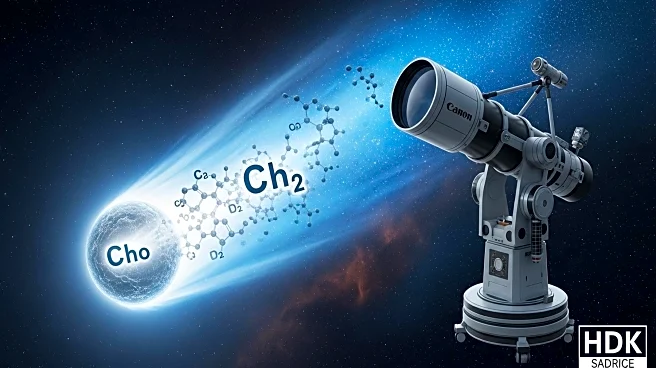What's Happening?
NASA's James Webb Space Telescope (JWST) has provided new insights into the interstellar comet 3I/ATLAS, revealing a high carbon dioxide-to-water ratio in its coma. Discovered on July 1, 2025, by the ATLAS survey telescope in Chile, 3I/ATLAS is the third confirmed interstellar object, traveling at speeds exceeding 130,000 mph. This velocity indicates its origin outside the solar system, as it is not gravitationally bound by the Sun. Researchers from NASA, the Jet Propulsion Laboratory, and several universities are studying the comet using JWST's spectrograph, which analyzes the chemical composition of the comet's coma. The findings suggest that 3I/ATLAS may have formed within the carbon dioxide ice line of its protoplanetary disk, leading to its high carbon dioxide content.
Why It's Important?
The discovery of 3I/ATLAS's unique chemical composition provides valuable information about the formation and characteristics of interstellar objects. Understanding the high carbon dioxide levels could offer insights into the conditions of its protoplanetary disk, potentially influencing theories about planet and comet formation in other star systems. This research enhances our knowledge of interstellar space and the materials that travel through it, which could have implications for future space exploration and the study of cosmic phenomena. The findings also contribute to the broader understanding of how interstellar objects differ from those formed within our solar system.
What's Next?
Observations of 3I/ATLAS will continue until September, when the comet will be too close to the Sun for further study. Researchers aim to gather as much data as possible before it exits the solar system, never to return. The ongoing analysis may refine existing hypotheses about its formation and chemical makeup, potentially leading to new discoveries about interstellar comets. As the study progresses, scientists will continue to collaborate using various telescopes and instruments to maximize the information obtained from this rare interstellar visitor.
Beyond the Headlines
The study of 3I/ATLAS highlights the challenges and opportunities in observing interstellar objects. These objects are exposed to intense radiation as they travel through space, which can alter their chemical composition. Understanding these changes is crucial for interpreting data from interstellar comets and could lead to advancements in space observation techniques. The research also underscores the importance of international collaboration in astronomy, as multiple institutions and telescopes work together to study these fleeting cosmic phenomena.

